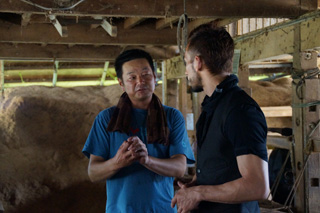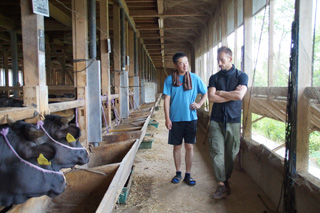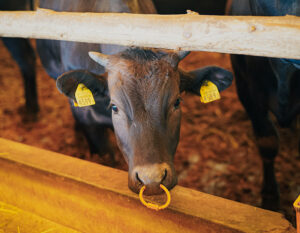Representing Japan, Yonezawa beef
”You not only produce beef, but also rice and ”sake”?!”
It’s not surprising that Nakata was flabbergasted. Father and son, Juichi and Hideyuki Juichi are famous as masters of cattle raising, but not only do they raise cattle, they also grow rice and vegetables, and also grow the “sake” rice “Miyama-Nishiki”, which they consigns to a local brewer to produce ”sake”.
Yonezawa beef is one of the leading brand beef in Japan that’s known to virtually anybody. Originally, there was no custom in Yonezawa to eat beef very often. A certain Dallas, who was invited to Yonezawa as an English teacher during the early Meiji era, wished to eat beef and had a farmer sell his cattle. That was the beginning of beef in Yonezawa. The story goes that Dallas was so impressed by the beef that when he returned to Yokohama from Yonezawa, he brought back a large amount of beef with him.
The Suzukis raise the finest of that Yonezawa brand beef.

Best beef in Japan
The outstanding character of Yonezawa beef is the smooth texture of the marbled fat. The sweetness of fat melts into your mouth. The deliciousness is instantly recognizable. But even among the delicious Yonezawa beef, Suzuki’s beef is rated as the best in Japan. Father Juichi won the Grand Prize at the national contest held at the Tokyo meat market. The son, Hideyuki also for raising award winning cattle in the local Yonezawa beef contest. Both produce what could be considered as top Japanese beef. The contest is held with the body of the cattle cut in half with all the internal organs removed. The meat is ranked at this point, such as A5 rank The cattle that the Suzukis raise are heifers (young female cow that have not produced offspring). Raised in Yonezawa where there are four seasons, the heifers have an appropriate amount of fat, resulting in good taste and flavor. “The texture is also good.” Suzuki added. It means that it is the most delicious beef, even among great tasting Yonezawa beef. However, to raise only female cattle has its own problems and it takes a lot of work, too. Still, Suzuki manages to raise and ship nearly 100 cattle. He also fattens some calves that were produced in Yonezawa. These are all going to be genuine Yonezawa beef of the finest grade.

Tasting great Yonezawa beef
When we left the barn, we were invited to the Suzuki household. We found some “sake” on the table. We were told that we’d be able to try the beef, but before that, we were served the “sake”.
“The meat that we are broiling now is not matured very much.”said Juichi-san.
“Do you mature beef too?”
“It tastes better if it’s hung with the bone for about a month.”
He explained that by maturing, amino acids are generated improving the taste.
Meat that is cut off the bone, sold in places like supermarkets have to set an expiration date. But left on the bone, it’s possible to allow them to mature. The maturing period depends upon the shop or the restaurant. As we listen to this, the meat is done and appears on the table. Words were not needed. It was delicious!
And of course, we had more “sake”, and then there were white rice balls, then more meat and more “sake” and before we knew it all the “sake”, rice, and meat were gone.





